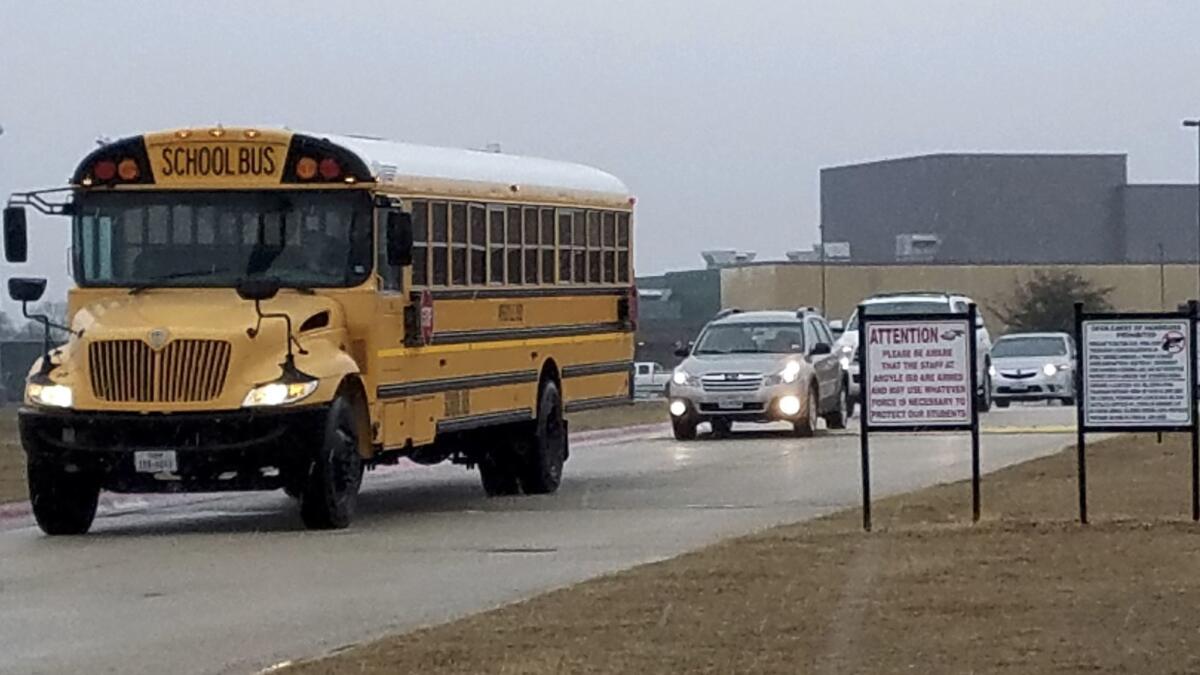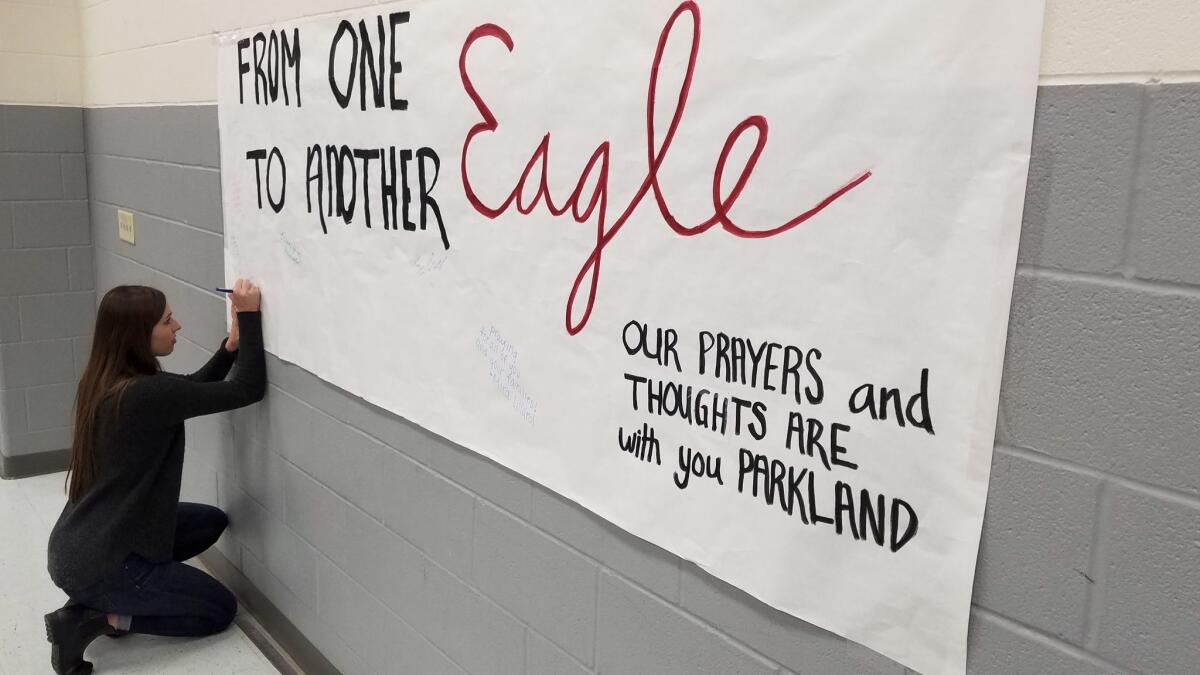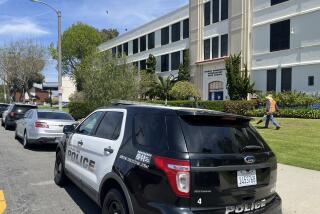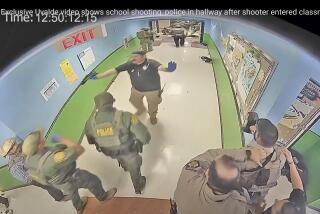As gun debate roils on, teachers in this Texas school are already armed

Reporting from ARGYLE, Texas — In the days since a 19-year-old gunman stormed onto his former high school campus in Parkland, Fla., killing 17 people with an AR-15 assault rifle, the nation has been embroiled in a debate over what to do about school violence: How do you make it stop?
Here at Argyle High School, they already have an answer to that question: The teachers are packing handguns.
A sign outside campus warns: “Please be aware that the staff at Argyle [Independent School District] are armed and may use whatever force is necessary to protect our students.”
Among those arriving Thursday was teaching assistant Theresa Locastro, who said the school board’s decision to allow staff to be armed after the Sandy Hook Elementary School massacre in 2012 “set an example for various schools that we mean business.”
“I know there’s a lot of controversy, and people who don’t want to arm them,” said Locastro, 44. But she thinks armed staffers can deter attacks like the Parkland gunman. “Hopefully, it will make them think twice,” she said.
In about two dozen states, including California, schools can allow staff to carry guns on campus, although some require concealed-carry licenses, according to the National Conference of State Legislatures.
Experts say it’s not clear whether such policies reduce the likelihood of school shootings or the death toll. But President Trump and other lawmakers have voiced support for arming teachers — on Thursday the president suggested giving bonuses to school staff members who carry guns. Officials at Argyle and other districts say the policies deter shooters and provide peace of mind, and that other schools should follow their lead. Scores of Texas school districts allow teachers to carry arms.

A sign outside campus warns: “Please be aware that the staff at Argyle [Independent School District] are armed and may use whatever force is necessary to protect our students.”
“It’s essential to keep us safe,” said Lizzie Dagg, 18, Argyle senior class president, who spent part of lunch Thursday signing a banner expressing sympathy to Parkland students.
“We’re going to protect our kids at any cost,” said U.S. history teacher Sharon Romero, a gun owner who did not volunteer to be armed at school, but is glad co-workers did. She’s disappointed that lawmakers haven’t done more to enact “common-sense” regulations, such as expanded background checks.
“At least we’re taking action,” she said. “I feel safer coming to work than a lot of other teachers in this country do.”
Ari Freilich, a San Francisco-based staff attorney with the Giffords Law Center to Prevent Gun Violence, said studies have shown more permissive concealed-carry laws contribute to gun violence, although he was not aware of studies at schools.
Freilich said that many teachers are already overwhelmed and that “asking them to be first responders too is not in the interest of students.”
Amy Klinger, co-founder of the Ohio-based Educator’s School Safety Network, said that rather than arming them, schools should train teams of educators to assess threats. The calls by Trump and others for guns in schools have “really taken the focus off things that are more effective,” she said. “We need to do things that work, not that feel good.”
Klinger said more guns on campus can lead to more accidental shootings, including two earlier this month in Minnesota and Florida, and it’s unreasonable to expect even armed staff on large campuses to be able to stop a mass shooter.
“We need to train our teachers how to identify these people. People don’t want to hear that — they want a quick fix,” she said.
In Texas, school boards must approve arming teachers. At least 170 districts allow employees and in some cases board members to carry firearms, according to the Texas Assn. of School Boards. About 150 districts have their own police departments, and more than 250 districts without police have school resource officers.
That means about 22% of the state’s public school districts have allowed staff to carry guns, according to Joe McKenna, director of research and education at the Texas School Safety Center at Texas State University in San Marcos.
The center works with the Argyle Independent School District and other school systems to improve security and preparedness. McKenna said the center has not studied the effectiveness of arming teachers.
“You have to weigh what’s best for your district, taking into account the district size, mitigation and threats,” he said.
Overwhelmingly Republican, Texas is known for supporting gun rights. The National Rifle Assn. is holding its annual convention in Dallas this May, just a few years after convening in Houston. Texas had more guns registered last year than any other state (588,696), followed by California (344,622) and Florida (343,288).
Texas voters have passed several laws in recent years expanding the right to carry guns openly and on college campuses. Government offices and businesses that don’t allow people to openly carry must post signs at their entrances.
But Texas has also seen support for gun control grow. Protesters rallied to oppose campus-carry rights two years ago, mostly notably at the University of Texas at Austin, where opponents formed the “Gun Free UT” alliance.
Some faculty even resigned rather than teach with guns in their classrooms. They worried not only about potential attacks by disturbed shooters, but also about guns firing accidentally or getting lost. Last week some of their fears were borne out when two guns were found left behind in women’s restrooms on two different campuses of UT Austin.
Argyle officials consulted other schools that had already armed teachers before approving the policy. Supt. Telena Wright called her counterpart at the nearby Harrold Independent School District, among the first in the country to arm teachers. It’s a tiny district — just 115 students — in a county the size of Rhode Island policed by half a dozen sheriff’s deputies; response time is a concern.
Harrold Supt. David Thweatt had proposed arming teachers after the shooting at West Nickel Mines School in Pennsylvania’s Amish country in 2006. School board members initially balked, then changed their minds after the mass shooting that killed 32 that spring at Virginia Tech.
Thweatt has since worked with Texas state lawmakers to pass a law providing training for school staff who serve as armed “guardians.” He tells those who call for advice to keep armed staff anonymous, like air marshals, and to have them carry their weapons at all times.
“You need to be ready,” Thweatt said.
Thweatt said he spends less than $1,000 on training and arming teachers, and that bigger districts might pay more but have comparably larger budgets. “It’s very cost-effective,” he said.
Argyle is a much larger, fast-growing district, with 2,400 students, 850 of them at the high school. Before the school board approved the policy, officials held a town hall that hundreds of residents attended. Many spoke during public comment — all in favor of arming, the superintendent said.
“After that night, I knew the community was going to be solidly behind it,” Wright said, and feedback from parents and staff continues to be positive. School officials have fielded calls from districts in Michigan, Oregon and Virginia.
Argyle High Principal James Hill, who has three children in the school system, was skeptical about the policy when he was hired in 2015, but said, “Now I’m a believer.”
“The time for us just sitting back and waiting for it to happen is over,” he said of school shootings. “… I want to give our kids a fighting chance.”
Staff who volunteer to be armed must have their concealed handgun license and pass psychological screening, according to Argyle Schools Police Chief Paul Cairney.
Staff who are approved carry handguns, either their own or those provided by the district, which Cairney also screens to ensure they work. Volunteers attend three to five days of training initially, and annual retraining, including active-shooter simulations.
“Our teachers carry the gun on them at all times. That’s because if something happens, it’s going to be precious seconds and we want them to be able to immediately enter the fight,” he said.
District officials declined to say how much the program costs, how many staff volunteer, and which are armed, but Cairney said they’re at every school.
He said staff haven’t had any accidents or guns go missing since the program started. He stressed that arming staff is not the district’s sole security strategy. They also monitor school-issued student laptops; got a new system to check social media; and lock entrances and electronically screen the identification of all who enter the schools, even parents and former students.
On Thursday, walking through the school’s halls, Cairney noted that he had passed several armed staff. Since the Florida shooting, more staff have volunteered to carry weapons.

molly.hennessy-fiske@latimes.com
Twitter: @mollyhf
More to Read
Sign up for Essential California
The most important California stories and recommendations in your inbox every morning.
You may occasionally receive promotional content from the Los Angeles Times.











